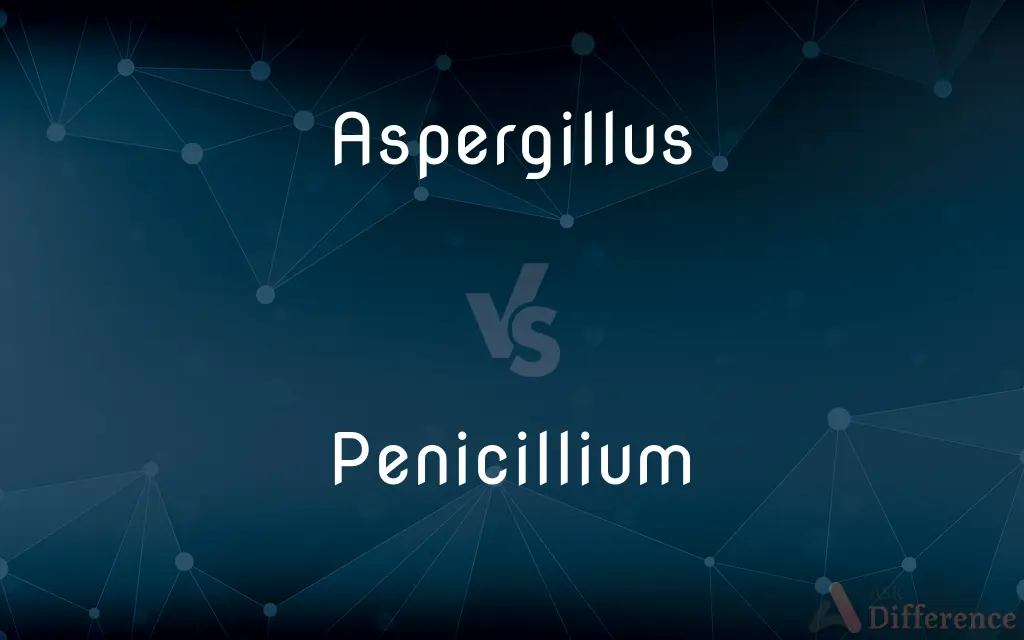Aspergillus vs. Penicillium — What's the Difference?
By Tayyaba Rehman & Maham Liaqat — Updated on March 14, 2024
Aspergillus is known for its role in fermenting foods and producing aflatoxins, whereas Penicillium is famed for its contribution to antibiotics like penicillin and cheese making.

Difference Between Aspergillus and Penicillium
Table of Contents
ADVERTISEMENT
Key Differences
Aspergillus is a genus of molds that is often associated with the fermentation of various foods and beverages, contributing to the distinctive flavors of many traditional cuisines. On the other hand, Penicillium is best known for its role in the discovery of penicillin, the first antibiotic, which has had a profound impact on modern medicine.
Both Aspergillus and Penicillium are found ubiquitously in the environment, thriving in soil, decaying vegetation, and other organic matter. However, Aspergillus tends to prefer warmer and drier conditions, while Penicillium is more commonly found in cooler and damp environments.
In terms of industrial applications, Aspergillus species are used in the production of enzymes, citric acid, and soy sauce, highlighting their versatility in biotechnology. Penicillium, meanwhile, is not only crucial in pharmaceuticals but also in the food industry, particularly in cheese production, where it is responsible for the characteristic flavors and textures of certain cheeses.
While both genera have beneficial uses, they can also pose risks to human health. Some Aspergillus species produce aflatoxins, potent carcinogens that can contaminate food crops. Penicillium species, though generally less harmful, can cause allergic reactions and respiratory issues in susceptible individuals.
Despite these risks, the study and utilization of Aspergillus and Penicillium continue to advance various scientific fields, from medicine to food science, demonstrating the dual nature of these fascinating fungi.
ADVERTISEMENT
Comparison Chart
Applications
Fermentation, biotechnology
Antibiotics, cheese making
Environment
Warmer, drier conditions
Cooler, damp environments
Health Impact
Aflatoxin production, potential allergen
Allergic reactions, respiratory issues
Industrial Use
Enzymes, citric acid production
Pharmaceutical, food industry
Contribution to Science
Food science, fermentation processes
Medicine, biotechnology
Compare with Definitions
Aspergillus
A genus of molds known for fermenting foods.
Aspergillus soyae is used in the fermentation of soy sauce.
Penicillium
A genus of molds instrumental in antibiotic discovery.
Penicillium chrysogenum was the source of the first penicillin.
Aspergillus
Present in various environments.
Aspergillus spores can be found in the air, soil, and decaying leaves.
Penicillium
Commonly found in cooler, damp conditions.
Penicillium spores thrive in environments with high humidity.
Aspergillus
Utilized in industrial enzyme production.
Aspergillus niger is used to produce citric acid in large quantities.
Penicillium
Can cause allergies and respiratory issues.
Exposure to Penicillium mold can trigger asthma symptoms in sensitive individuals.
Aspergillus
Can cause respiratory infections in immunocompromised individuals.
Aspergillus fumigatus can lead to aspergillosis in vulnerable patients.
Penicillium
Used in cheese production.
Penicillium roqueforti is used to make Roquefort cheese.
Aspergillus
Can produce harmful aflatoxins.
Aspergillus flavus contamination in grains can lead to aflatoxin poisoning.
Penicillium
Versatile in biotechnology applications.
Penicillium species are studied for their potential in producing other antibiotics and enzymes.
Aspergillus
Aspergillus () is a genus consisting of a few hundred mould species found in various climates worldwide. Aspergillus was first catalogued in 1729 by the Italian priest and biologist Pier Antonio Micheli.
Penicillium
Penicillium () is a genus of ascomycetous fungi that is part of the mycobiome of many species and is of major importance in the natural environment, in food spoilage, and in food and drug production. Some members of the genus produce penicillin, a molecule that is used as an antibiotic, which kills or stops the growth of certain kinds of bacteria.
Aspergillus
Any of various fungi of the genus Aspergillus, which includes many common molds.
Penicillium
Any of various characteristically bluish-green fungi of the genus Penicillium that grow as molds on decaying fruits and ripening cheese and are used in the production of antibiotics such as penicillin and in making cheese.
Aspergillus
Any of many molds, of the genus Aspergillus, many of which are pathogenic.
Penicillium
Any of the blue-green fungi, of the genus Penicillium, that are used in the manufacture of cheeses, and are an important source of antibiotics.
Aspergillus
Genus of common molds causing food spoilage and some pathogenic to plants and animals
Penicillium
Genus of fungi commonly growing as green or blue molds on decaying food; used in making cheese and as a source of penicillin
Common Curiosities
What is Penicillium?
Penicillium is a genus of molds famous for the discovery of penicillin and its use in cheese making.
What industrial applications do Aspergillus have?
Aspergillus is used in producing enzymes, citric acid, and in the fermentation of foods like soy sauce.
Can Aspergillus and Penicillium pose health risks?
Yes, Aspergillus can produce aflatoxins, and Penicillium can cause allergic reactions and respiratory issues.
How can Penicillium exposure affect health?
Exposure to Penicillium can trigger allergic reactions and exacerbate respiratory conditions like asthma.
Can Aspergillus contaminate food?
Yes, certain Aspergillus species can contaminate food crops with aflatoxins, which are carcinogenic.
What is Aspergillus?
Aspergillus is a genus of molds known for its role in fermentation and biotechnology.
How does Penicillium contribute to the food industry?
Penicillium is crucial in cheese production, adding flavors and textures to cheeses like Roquefort and Camembert.
What are the health implications of Aspergillus exposure?
Exposure to Aspergillus can lead to respiratory infections, particularly in immunocompromised individuals.
What role does Penicillium play in antibiotic production?
Penicillium was the source of the first antibiotic, penicillin, revolutionizing modern medicine.
How are Aspergillus and Penicillium different in their environments?
Aspergillus prefers warmer, drier conditions, whereas Penicillium thrives in cooler, damp environments.
How is Aspergillus used in food production?
Aspergillus is involved in the fermentation of various foods and beverages, enhancing their flavors.
Are there beneficial uses of Aspergillus in science?
Yes, Aspergillus is used in biotechnology for enzyme production and food science for fermentation processes.
What precautions should be taken with Aspergillus and Penicillium?
Minimizing exposure in susceptible individuals and ensuring food safety can mitigate health risks associated with these molds.
Is Penicillium always harmful?
No, while some species can cause health issues, many have beneficial applications in food and medicine.
What are the scientific contributions of Penicillium?
Penicillium has contributed significantly to medicine through antibiotics and biotechnology research.
Share Your Discovery

Previous Comparison
Accrual vs. Provision
Next Comparison
Demotivated vs. UnmotivatedAuthor Spotlight
Written by
Tayyaba RehmanTayyaba Rehman is a distinguished writer, currently serving as a primary contributor to askdifference.com. As a researcher in semantics and etymology, Tayyaba's passion for the complexity of languages and their distinctions has found a perfect home on the platform. Tayyaba delves into the intricacies of language, distinguishing between commonly confused words and phrases, thereby providing clarity for readers worldwide.
Co-written by
Maham Liaqat













































